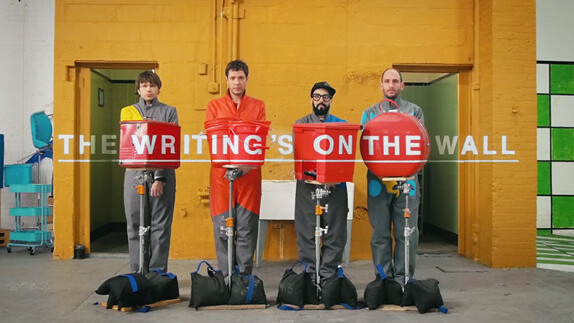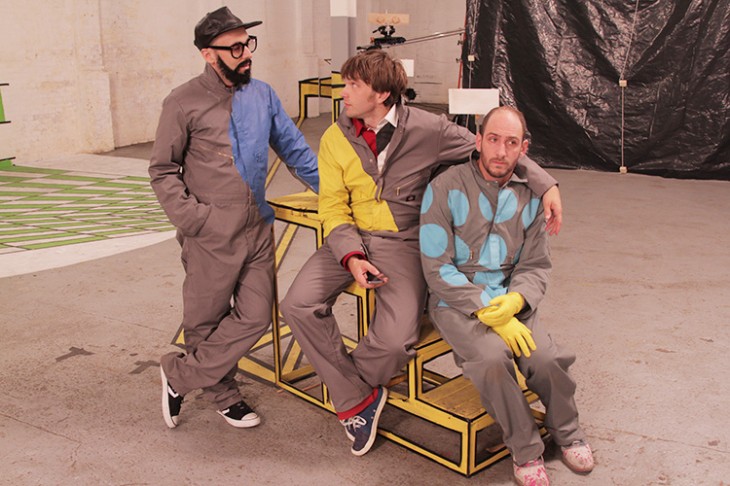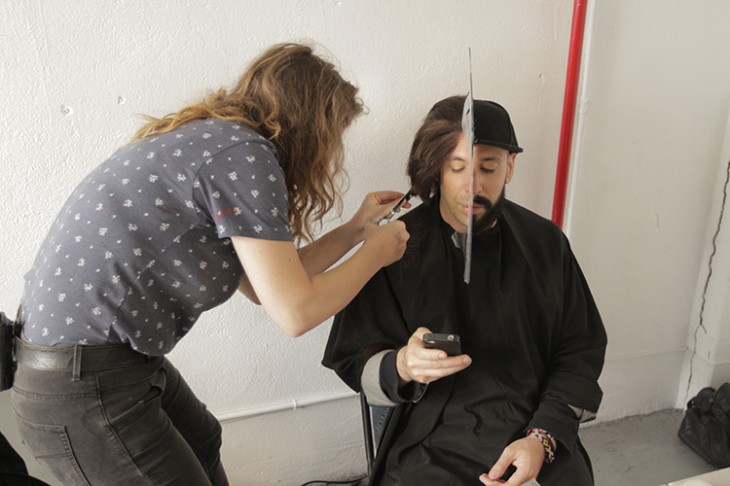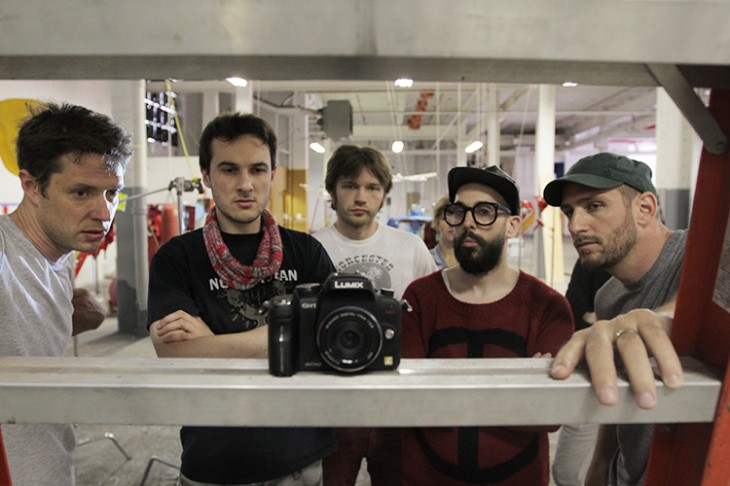
Doug Levy is a staff copywriter and editor for the Shutterstock blog. This post was originally published on the Shutterstock blog and has been reprinted with permission.
OK Go band members are masters of the viral music video. Since releasing a clip for their 2005 second-album single A Million Ways, which featured them doing a wonderfully choreographed, synchronized dance in a single take, they’ve been consistently one-upping themselves by creating more and more elaborate concepts for their videos.
Things really blew up with the release of the now-legendary “treadmill” video for Here It Goes Again—another single off of 2005’s Oh No—and since then, the band has continued to astound viewers by utilizing everything from a giant Rube Goldberg machine, live stop-motion, and a customized off-road course to a camouflaged marching band, trained dogs and the Muppets.
So it’s no surprise that the video for OK Go’s latest single, The Writing’s on the Wall, is yet another feat of ingenuity and visual wonder. Heralding the release of the band’s upcoming album, Hungry Ghosts, the clip—shot with the new 4K Panasonic LUMIX GH4— is a compendium of optical illusions orchestrated in physical space, with the band (and crew) running like madmen to execute everything in time with the song.
After re-watching the video enough to make sure we didn’t miss a trick, we immediately reached out to OK Go frontman Damian Kulash and Aaron Duffy, one of his co-directors on the clip, to find out how they made this all happen. Watch the video for yourself above, and when you’re finished hitting “replay,” read on for our exclusive interview, along with behind-the-scenes footage and photos from the shoot.
Shutterstock: Where did the concept for this come from? Do you feel a lot of pressure to keep coming up with new high-concept ideas every time you make a video?
Damian: A few years ago, I saw this ident for the UK TV Channel Film 4. The thrill of seeing the logo emerge anamorphically seemed similar to the feeling we’re usually going for in our videos—a sense of wonder and surprise. So I stored away the idea until I met the right people for making a bigger, more ambitious take on it. And over the intervening years, I learned about the artwork of Felice Varini and Georges Rousse, both of whom were big inspirations while we worked on this.
As for the pressure to make videos, it’s from within, not without. Every time we make something, it feels like a jumping-off place for making something else, and I think getting inspired to reach a little farther each time is just in our constitution. Tim has been my best friend since we were 11 years old, and chasing our creative ideas has always been the core of our relationship.
What were the main challenges of shooting this video? Were there any unexpected hurdles?
Aaron: I wouldn’t call them hurdles, exactly, but there were risks. Many of the illusions and setups that we designed had their challenges, but we knew we could create each of them. However, we didn’t know if we could make them all work together in one single shot, with the band getting to each setup in time with the music.
On top of that, while the illusions had a great impact in concept, we didn’t know if they would come through properly on camera. Some illusions just work better in person. We realized that we had to capture it in a way that made the viewer feel more like they were there in order to make the illusions really stand out. That’s why you see the band positioning the camera a lot of the time.
What’s the craziest thing that happened behind the scenes?
Damian: It’s not exactly behind the scenes, but Tim had to walk around NYC with half a beard for the better part of a week, and that garnered some pretty intense stares. And I don’t know if this counts as crazy, but the video really was made possible by the insane talents of many different people on the crew. There’s a video (see below) that shows how intense the off-screen choreography was. And you can also see in that video some of the ingenious camera rigs built by our co-director, Bob Partington. They’re every bit as beautiful as the video itself.
And the makeup crew? Incredible. Tim had less than 20 seconds to remove his prosthetic half-beard, take off a full suit of clothes, run up a flight of stairs, don a mirror laser-cut to his profile, and hit his mark before the camera caught up with him. It’s incredible that the makeup folks managed to get the beard removal down to something like 5 seconds. That’s crazy.
What was the development process like? Did you work on one aspect at a time, or multiple things at once?
Aaron: We began by listing all of the ideas and visual moments that we were excited about. Each of the three of us had some visuals that we’d always wanted to do, but never had the opportunity to make them happen. This was our chance. We ended up with more of them than we could do in 3.5 minutes, so we narrowed them down to our favorites. But still, we didn’t know the order or how they would build into a climax with the song.
It wasn’t until we arrived in the space that we started mapping it out and the pieces began falling into place. At that point, a lot of things started happening at once, partially because we finally had a full vision, but also because we only had two weeks until we had to shoot. Originally, we planned on having two shoot days, but we were working on final execution until the very last minute, before giving ourselves only about nine hours to shoot.
How do you approach the physical challenges of your videos? Are you all just naturally well-coordinated people?
Damian: No, we are not naturally well-coordinated. We’ve spent most of the last 15 years on tour together, though, and playing on stage really is just an exercise in group coordination. During the non-touring windows, of course, we’ve made a lot of pretty elaborate videos, and those often require a lot of practice, too. So through sheer repetition, we’ve developed some skills at executing our little parts of complicated systems or routines. But none of us are particularly gifted dancers or athletes or anything like that. Tim is a very stylish and stylized dancer—the rare drunken night for him is a huge gift to the rest of us—but that’s about it.
Why do you think it’s important to shoot in one take?
Aaron: In order to truly make the most of all the visual moments and keep the audience engaged, the last thing we wanted to do was distract from the feeling of being there. If we can make the audience feel like the camera is their uninterrupted view of the space, then we’ve created a video with really strong visual and conceptual integrity.
I think the audience appreciates that, because they can see the challenge. The band isn’t pretending to be scrambling from one point to the next—they truly are scrambling. Yet, when they pull it off, we’re rooting for them. Whether it’s an obstacle course or a choreographed dance, you can feel that same sense of achievement in all of OK Go’s videos.
Do you try to do anything for your live performances that recreates the visual feel of your videos?
Damian: Our live show is very visual, but we don’t usually make specific references to the videos. The thrill of a live show is the collective connection; it’s feeling everyone in the room line up on the same wavelength, and the joy and excitement spreading contagiously from crowd to stage and back. So we try to stay away from visuals that are too figurative, or too much like TV. As for what’s expected of us, I think our fans have come to expect a pretty insane party of a show. It’s elaborate, but more in a rollicking way than the precision of our videos.
What one thing would you tell people about the video that they would never guess just from watching it?
Aaron: There are a couple of things that fall into that category. For one, the take that we used was shot some time between 2:45 am and 3 am. Something else the viewer can’t see is that there are about five people behind the camera, almost at all times, hiding from view but keeping the whole thing running smoothly. I was one of them—moving quickly with an iPad in my hands in order to watch what the camera was shooting through a dedicated WiFi signal from the GH4. There were many moments where we had to dart very quickly from place to place in order to avoid the view of the camera.
Are there any glitches or things that didn’t work out the way you expected in the final video?
Aaron: There were some parts of the sequence that would be different every time we shot a take. Tim had to really rush up the stairs before he put on his mirror face, which meant that the mirror was arranged differently every time. If that mirror was positioned too far on one side, it would distort his face in an intense way, making the take unusable. We had many incomplete run-throughs before we started nailing it. We shot around 60 takes, but there were really only a handful that we ended up watching through before we chose our final select.
What other artists out there right now (visual, musical, or otherwise) do you find really inspiring?
Damian: Hozier’s “Work Song” is one of the most moving songs I’ve heard in years. I love everything I’ve heard by Jai Paul so far. The writing of David Foster Wallace is always hugely inspiring to me, so I re-read his stuff a lot. George Saunders’ short stories really inspire me, too. I think what Elan Lee is doing is mind-blowing. Mike Bostock also frequently blows my mind: look at this. Adam Harvey makes awesome stuff; I particularly like CV Dazzle. The artwork of Tom Friedman is amazing and makes me super happy. I am also super into David Wilson.
Has OK Go become an entity that needs to be seen as much as heard to be fully appreciated, or do you think people still “get it” simply by hearing your music?
Damian: I definitely don’t think you need to see the video to like the song. As it happens, people will mostly learn about the song by having the video shared with them, but I’m certainly not complaining about that. There’s a general assumption that we, as a band, must feel ashamed by the the disproportionate attention paid to our videos, as if their success somehow disqualifies our music from being good, also. Which, if you put yourself in my shoes, is just flat-out crazy.
Think of it this way: I’m a chef, and you’re in my restaurant. We’re world-famous for having incredible desserts. And your question is: Do people have to eat the desert to enjoy the main course? From where we stand, it’s a wonderful thing that that we have such good desserts, and we feel blessed that they’re known around the world for being delicious and singular and unique and unlike anyone else’s. If millions come in for the desserts, and hundreds of thousands also find they like the main course, awesome. There are no bad customers in this restaurant.
It used to be that music and film and video games and journalism were actually very different physical objects with industries built around selling and distributing them. Now all of us make ones and zeros. I spend my time chasing my creative ideas. My process generally starts with writing songs, but it leads to a lot of other fun places. I feel bad for musicians who get trapped in the box of “music” as it was imagined 30 years ago. Some people like it in that box—their singular passion is playing guitar, say—but a lot don’t. A lot of people wish they were given license to chase all of their creative ideas, not just the ones that get encoded as sound files. We are the lucky guys who aren’t trapped in that particular box.
To explore all of OK Go’s videos, head over to the OK Go Official Music Videos playlist on YouTube.
Get the TNW newsletter
Get the most important tech news in your inbox each week.


